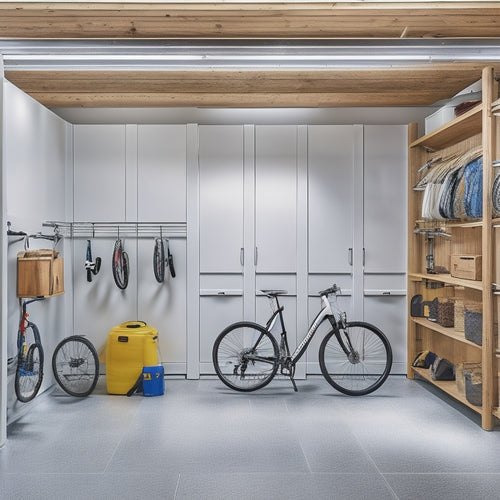
Revitalize Your Home: Restore Wooden Windows Now
Share
You're one worn-out window away from letting the charm and character of your home slip through your fingers. To revitalize your home, start by evaluating the condition of your windows, identifying areas that need repair, replacement, or cleaning. Evaluate the repair priorities and compile a list of necessary fixes. Master sanding techniques, repair rot, and clean, prime, and paint the frame for durability. Establish a regular maintenance routine to make sure your restored windows last. By doing so, you'll not only save costs and reduce environmental impact but also preserve your property's historical charm. Now, take the first step towards revitalizing your home - and discover the full benefits that await you.
Key Takeaways
• Assess your windows' condition to identify areas needing repair, replacement, or cleaning, and prioritize tasks accordingly.
• Master sanding, rot repair, and painting techniques to ensure a smooth, durable finish for your restored windows.
• Regular maintenance is crucial; establish a routine that includes cleaning, inspecting, and applying a waterproofing agent to protect your windows.
• Restoring your wooden windows can save you money, reduce environmental impact, and preserve your property's historical charm.
• Create a detailed budget breakdown to allocate funds effectively, considering material selection, time, and effort for a successful DIY project.
Assessing Window Condition and Needs
As you embark on the wooden window restoration process, carefully examine the window's condition to identify areas that require repair, replacement, or simply a good cleaning. Note any signs of rot, damage, or wear that may affect the window's functionality or aesthetic appeal.
You'll need to evaluate repair priorities, determining what needs attention first. This will help you select appropriate materials for the job, whether it's wood filler, glazier putty, or new glass.
Compile a list of the necessary repairs and replacements, and prioritize them based on urgency and importance. By doing so, you'll guarantee a thorough and effective restoration process that brings your wooden windows back to their former glory.
Restoration Techniques and Best Practices
To achieve a professional-grade restoration, you'll need to master a range of techniques, from addressing problem areas to sanding and painting the window frame. Start by evaluating the condition of your windows and tackling any issues, such as rot or damage, using wood filler and glue.
Here are some essential restoration techniques to keep in mind:
-
Sanding techniques: Use a combination of grits and electric sanders to maintain the window fit and achieve a smooth finish.
-
Repairing rot: Evaluate the extent of the damage and replace any rotten wood, ensuring a secure and durable repair.
-
Priming and painting: Clean, prime, and paint the frame using suitable products, applying multiple coats for durability and a smooth finish.
Maintaining Your Restored Windows
You'll need to establish a regular maintenance routine to make sure your newly restored wooden windows continue to function smoothly and maintain their appearance over time. Cleaning tips are essential: use a soft-bristled brush and mild detergent to remove dirt and grime from the frames and sashes.
For seasonal maintenance, inspect your windows before winter to guarantee they're sealed properly, and apply a waterproofing agent to protect them from harsh weather. Regularly check for signs of damage, such as rot or cracks, and address them promptly.
Benefits of Wooden Window Restoration
By restoring your wooden windows, you're not only preserving the historical charm of your property but also reaping a range of benefits that extend far beyond aesthetics.
Here are just a few advantages you can expect:
-
Cost savings: Restoring your wooden windows can be more cost-effective than replacing them with new ones, especially if you're dealing with historically significant or unique windows.
-
Environmental impact: By choosing to restore rather than replace, you're reducing waste and minimizing the environmental impact of manufacturing new materials.
-
Increased property value: Restored wooden windows can add significant value to your property, making it more attractive to potential buyers if you ever decide to sell.
Budgeting for Your Project
Estimating the total cost of your wooden window restoration project involves breaking down the expenses into materials, labor, and potential extras, allowing you to plan and budget accordingly.
A detailed cost breakdown will help you allocate funds effectively. Consider the material selection, as high-quality materials may increase the overall cost.
If you're opting for DIY options, factor in the time and effort required for each task. Create a realistic restoration timeline to avoid delays and additional expenses.
Be prepared for unexpected costs, such as glass replacement or brass handle restoration. By budgeting wisely, you'll be able to restore your wooden windows efficiently and enjoy the benefits of a revitalized home.
Frequently Asked Questions
Can I Restore Windows Myself, or Do I Need a Professional?
You can restore windows yourself, but assess your DIY feasibility and restoration timeline first; consider your skill level, time commitment, and window condition to determine if professional help is needed for a successful outcome.
How Do I Choose the Right Type of Paint for My Windows?
As you begin on this vibrant journey, remember that selecting the right paint for your windows is like finding the perfect puzzle piece - it completes the picture. You'll want to explore Color Options like rich wood tones or crisp whites, and consider Finish Types like matte, satin, or gloss to achieve the desired look.
Are There Any Specific Building Codes for Window Restoration?
You'll need to research local ordinances and historic regulations governing window restoration in your area, as they may impact your project's scope, materials, and timeline, ensuring compliance and preserving your home's original charm.
Can I Restore Windows With Lead-Based Paint Safely?
You must prioritize safety when restoring windows with lead-based paint; start by conducting lead testing, then follow strict safety protocols, including wearing protective gear, containing the work area, and proper disposal to minimize exposure risks.
Will Restored Wooden Windows Be Energy Efficient?
As you envision a cozy winter morning, free from chilly drafts, you'll be delighted to know that restored wooden windows can be energy efficient with proper window insulation, yielding significant energy savings and a warmer, more comfortable living space.
Related Posts
-

What to Look for in a Pegboard Tool Storage Kit
When shopping for a pegboard tool storage kit, you need a system that combines customized organization, sturdy durabi...
-

Custom Pegboard Storage for Your Workshop
You're looking to create a custom pegboard storage system that maximizes your workshop's space, enhances productivity...
-

Modular Garage Organizers for Clutter-Free Spaces
You're likely wasting precious space in your garage due to inefficient storage and poor organization, but modular gar...


